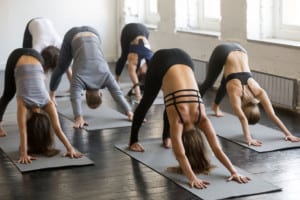Before entering a yoga instructor course, many people ask, “What kind of yoga should I teach?” There is a soul searching process based on passion and the popularity of classes. One might want to teach an obscure style because of a deep passion and calling, but not every prospective student is deeply curious about styles they have never heard of. Today, there are several styles of yoga to both practice and teach. While this is ultimately a good thing, how do you know where to begin when choosing which one to instruct?
What’s the Difference?
Every yoga style has its own specific focus. Some focus on slow, deliberate stretching intended on improving flexibility and mobility. Others are more aerobically intense with movements designed to build strength and make you sweat. Whether you’re interested in transitioning from a yoga student to a yoga teacher or a current teacher looking to explore new disciplines and certifications, you are still wondering, “What kind of yoga should I teach?” So, let’s look at the popular styles of today.
Consider These 7 Popular Yoga Styles
Below, you’ll find key information regarding seven of today’s most popular yoga styles. Each is ranked in order according to their popularity and number of internet searches. That’s right; since you’ll be using your passion for yoga to actually earn a living, it’s important to think about the process from a business perspective. You need to give your clients what they want, which takes some research. As of this day, my research revealed the following:
Hot yoga – 48,392 monthly searches
Bikram yoga – 33,950 monthly searches
Kundalini yoga – 32,833 monthly searches
Hatha yoga – 28,808 monthly searches
Yin yoga – 22,833 monthly searches
Ashtanga yoga – 22,150 monthly searches
Vinyasa yoga – 21,125 monthly searches
(Source: wordtracker.com)
Let’s Reflect on Research
One point to mention about research in general: This is only an indication of the styles that prospective teachers and students research on the Internet. We have all seen crowds of students in Vinyasa, Hatha, and Kundalini classes. Therefore, the information above is not a clear indication of how many students are going into classes of each style. It does give us a ball park figure of what students search for and recognize as popular styles today.
Hot Yoga
The numbers don’t lie – hot yoga is the most popular yoga style for searches. That said, not everyone gravitates to it. Why? Well, as a hot yoga instructor, you’ll help your students discover how their bodies react to practicing yoga in uncomfortable heat. In fact, most hot yoga sessions take place in heated rooms up to 108 degrees.
Hot Air?
While there isn’t much research supporting the benefits of practicing hot yoga, many practitioners praise its ability to help deepen their stretches. In fact, hot yoga practitioners are a passionate bunch. It has also become increasingly popular in recent years, making it an obvious choice when selecting a yoga style to teach. Just make sure you can handle the heat. What kind of yoga should I teach? It gets complicated and it’s much deeper than passion.
Bikram
Like Hot Power Yoga, Moksha, and Baptiste, there are many forms of hot yoga. However, Bikram is by far the most recognized and popular style within the family. As is the case with every type of hot yoga, with Bikram, you must be ready to sweat. As a Bikram instructor, you’ll guide your students through a 90-minute sequence consisting of two breathing exercises and 26 specific poses in a room kept at 40 percent humidity and 105 degrees.
Controversy
On the downside, other than the heat, there is some controversy surrounding Bikram’s founder Bikram Choudhury. So, this is certainly something to consider. Additionally, high heat does present some risks to students with high blood pressure and heart problems. Therefore, you want to research contraindications and liability a bit deeper before making a commitment.
Kundalini
Thanks to Russel Brand, Gabrielle Bernstein, and several other celebrity devotees, Kundalini has garnered an almost cult-like following. Ideal for those seeking greater spirituality in their yoga practice, it’s quite different from your traditional yoga class. As a Kundalini instructor, you’ll help your students focus just as much on their internal well-being as their external. By coupling repetitive physical exercises with meditation, chanting, singing, and intense breath work, Kundalini allows its practitioners to tap into internal energies and attain greater self-awareness.
Hatha
Hatha is all about bringing your life into balance. Standing for “sun and moon” in Sanskrit, Hatha typically involves kriyas, bandhas, pranayama, meditation, and asana sequences, which are designed to energetically balance the feminine and masculine energies in each of us. As you can see, this particular style of yoga encompasses a range of modern philosophies. It draws on an array of practices to help teachers develop and share an enhanced level of depth.
Vinyasa
Vinyasa is another popular yoga style to both practice and teach. Stemming from Ashtanga, Vinyasa features set poses yet allows you to be creative while flowing from one pose to the next with your breaths. Every sequence in Vinyasa is designed to progressively build upon one another and evolve into increasingly advanced postures throughout each yoga class. Most Vinyasa yoga classes include a variety of seated, standing, and supine poses. However, Vinyasa is based on personal preferences, so it doesn’t need to be practiced at any specific temperature, tempo, or level.
Ashtanga
Ashtanga is ideal for students and teachers looking for a challenge and who want to approach yoga from a more orderly perspective. Great for “Type-A” personalities, this style of yoga is all about routine and following strict guidelines. When practicing Ashtanga, you’ll perform six series of yoga poses specifically sequenced to allow you to breathe and flow through each one. In each class, you’ll be leading students through the exact same poses in exactly the same order.
Yin
The opposite of Ashtanga, Yin is a less regimented, slower moving style of yoga designed to help practitioners find their Zen. Taking a more meditative approach, Yin poses are held for many minutes to target deep connective tissue and restore elasticity. While it’s common to feel a bit antsy at first, after a few classes, the restorative powers of Yin yoga will have your students hooked. The bliss and wisdom offered by Yin makes it one of the most satisfying yoga styles to practice and teach.
Restorative Yoga
The Restorative style is a type of yoga that is focused on relaxation. The poses are easy and gentle, and the class is typically slower paced than other types of yoga. This type of yoga can be beneficial for people who are dealing with stress or anxiety, or who want to learn how to relax their body and mind. If you’re thinking about teaching yoga, Restorative Yoga may be a good option for you. Restorative classes tend to use a variety of props. As a result, students relax into the posture by using gravity for resistance. Students who search out this kind of a class know what they are looking for and keep coming back.
Power Yoga
One of the new creative styles, Power yoga is a type of yoga that is usually based on the ashtanga style of yoga. However, Hatha and Vinyasa instructors have helped this style evolve into a physically challenging fusion of concepts. It is a physically demanding form of yoga that requires a lot of strength and stamina. Power yoga classes are usually very intense and focused. They often include a lot of sun salutations and vinyasas, as well as some inversions and arm balances. If you are thinking about teaching power yoga, it is important to make sure that you are physically fit enough to handle the demands of the practice.
Which Kind of Yoga Do You Want to Teach?
Yoga is an ancient practice that continues to evolve with its practitioners and each passing year. With so many different styles of yoga to explore, taking the first or next step in your journey as a yoga teacher can seem a little daunting. What kind of yoga should I teach? Regardless of which yoga discipline or style you decide to devote your time to, make sure to pick a practice that best aligns with your interests, research, and passion as a yoga instructor or soon-to-be yoga teacher. Following this path will provide you with the most satisfaction and success!
© Copyright – Aura Wellness Center – Publications Division
Click here to see our online Yoga Nidra teacher training course.
Are you an experienced teacher looking for YACEP credits or continuing education?
Subscribe to Our Newsletter for Special Discounts and New Products
Related Resources
52 Essential Principles of Yoga Philosophy to Deepen your Practice
by Rina Jakubowicz.
A Relaxing Way to De-stress, Re-energize, and Find Balance
by: Gail Boorstein Grossman.
YOGA: THE PATH TO HOLISTIC HEALTH
by B.K.S. Iyengar
TEACHING YOGA: Essential Foundations and Techniques
By Mark Stephens
Teaching Yoga As a Profession – Consultants and Mentors
Teaching Yoga: Student Safety is Top Priority


2 thoughts on “What Kind of Yoga Should I Teach?”